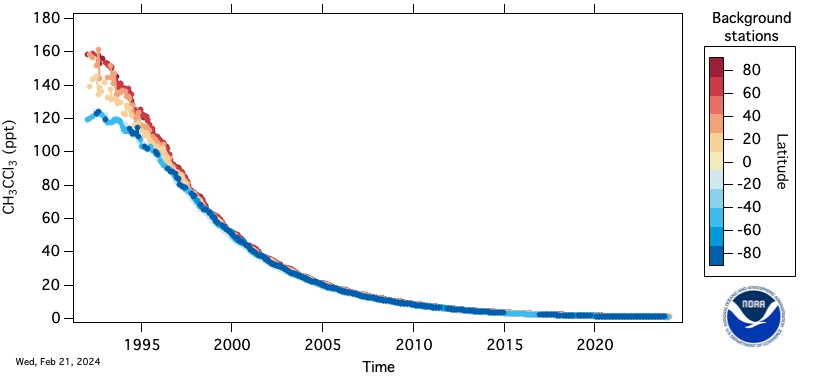CH3CCl3 (methylchloroform)
Currently, there are three GML programs that measure methylchloroform; two flask programs (GC-ECD and GC-MSD) and an in situ GC-ECD program. The longest and most complete measurement of CH3CCl3 is from the HATS flask GC-MSD program (data displayed below).

Atmospheric dry mole fractions (parts-per-trillion or ppt) of CH3CCl3 measured by GC-MSD in the HATS flask program. Each point represents a monthly mean at one of 8-12 stations: Alert, Canada (ALT), Summit Greenland (SUM), Barrow, Alaska (BRW), Mace Head, Ireland (MHD), Trinidad Head, California (THD), Niwot Ridge, Colorado (NWR), Cape Kumukahi, Hawaii (KUM), Manua Loa, Hawaii (MLO), American Samoa (SMO), Cape Grim, Australia (CGO), Palmer Station, Antarctica (PSA), South Pole, Antarctica (SPO).

Zonal mean dry mole fractions (ppt) are estimated from GC-MSD flask data by equally weighting monthly mean measurements in each latitude band. Small gaps (less than 6 months) are interpolated prior to averaging. Solid lines are used for Northern hemispheric measurements and dashed for the Southern hemisphere.
Selected Publications
- Montzka, S.A., M. Krol, E. Dlugokencky, B. Hall, P. Jockel, J.Lelieveld, Small interannual variability of global atmospheric hydroxyl, Science, 331, 67-69, 2011.
- Montzka, S.A., C.M. Spivakovsky, J.H. Butler, J.W. Elkins, L.T. Lock, and D.J. Mondeel, New observational constraints for atmospheric hydroxyl on global and hemispheric scales, Science, 288, 500-503, 2000.
